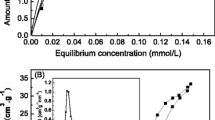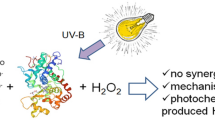Abstract
Gallic acid (3,4,5-trihydroxybenzoic acid, GA) which is a key component of humic acids in combination with imidazole affects the catalytic performance of pentachlorophenol (PCP) decomposition by a Fe-porphyrin catalyst via diverse mechanisms. GA can improve drastically the yield and the kinetics of the catalytic oxidation of PCP by a factor of 20. In the presence of GA, imidazole acts competitively with PCP consuming oxidative equivalents. The data of catalytic oxidation products indicate a mechanism where decomposition of PCP occurs through oxidative dechlorination, initialized by an oxo-ferryl porphyrin π-cation radical complex formed on the Fe-porphyrin catalyst.
Access this chapter
Tax calculation will be finalised at checkout
Purchases are for personal use only
Similar content being viewed by others
References
Christoforidis, K.C., M. Louloudi, E.R. Milaeva, Y. Sanakis, and Y. Deligiannakis. 2007. EPR study of a novel [Fe–porphyrin] catalyst. Molecular Physics 105: 2185–2194.
Christoforidis, K.C., M. Louloudi, E.R. Milaeva, and Y. Deligiannakis. 2010. Mechanism of catalytic decomposition of pentachlorophenol by a highly recyclable heterogeneous SiO2–[Fe-porphyrin] catalyst. Journal of Catalysis 270: 153–162.
Fukushima, M., and K. Tatsumi. 2005. Effect of hydroxypropyl-β-cyclodextrin on the degradation of pentachlorophenol by potassium monopersulfate catalyzed with iron (III) − porphyrin complex. Environmental Science and Technology 39: 9337–9342.
Stevenson, F.J. 1994. Humus chemistry: Genesis, composition, reactions, 2nd ed. New York: Wiley.
Acknowledgments
This research has been cofinanced by the European Union (European Social Fund – ESF) and Greek national funds through the Operational Program “Education and Lifelong Learning” of the National Strategic Reference Framework (NSRF) – Research Funding Program: Thales. Investing in knowledge society through the ESF.
Author information
Authors and Affiliations
Corresponding author
Editor information
Editors and Affiliations
Rights and permissions
Copyright information
© 2013 Zhejiang University Press and Springer Science+Business Media Dordrecht
About this paper
Cite this paper
Louloudi, M., Papastergiou, M., Perlepes, S.P. (2013). Mechanisms of Co-catalytic Action of Humic-Like Additives on Pentachlorophenol Oxidation by a Fe-Porphyrin Catalyst. In: Xu, J., Wu, J., He, Y. (eds) Functions of Natural Organic Matter in Changing Environment. Springer, Dordrecht. https://doi.org/10.1007/978-94-007-5634-2_98
Download citation
DOI: https://doi.org/10.1007/978-94-007-5634-2_98
Published:
Publisher Name: Springer, Dordrecht
Print ISBN: 978-94-007-5633-5
Online ISBN: 978-94-007-5634-2
eBook Packages: Earth and Environmental ScienceEarth and Environmental Science (R0)




